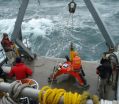(Press-News.org) Athens, Ga. – Water scarcity in the western U.S. has long been an issue of concern. Now, a team of researchers studying freshwater sustainability in the U.S. have found that the Southeast, with the exception of Florida, does not have enough water capacity to meet its own needs.
Twenty-five years ago, environmentalist Marc Reisner published Cadillac Desert: The American West and Its Disappearing Water, which predicted that water resources in the West would be unable to support the growing demand of cities, agriculture and industry. A paper co-authored by a University of Georgia researcher and just published in a special issue of the journal Proceedings of the National Academy of Sciences offers new support for most of Reisner's conclusions, using data and methods unavailable to him in 1986.
Although the paper focuses on freshwater sustainability in the Southwest, co-authors Tushar Sinha, a postdoctoral scientist at North Carolina State University; John Kominoski, a postdoctoral associate at the UGA Odum School of Ecology; and William Graf, a professor of geography at the University of South Carolina, said that the findings have important implications for the Southeast as well. "It turns out that the Southeast has a relatively low capacity for water storage," said Graf.
In order for water supply to be considered sustainable, the researchers calculated that no more than 40 percent of freshwater resources can be appropriated for human use, to ensure that streamflow variability, navigation, recreation and ecosystem use are accommodated. They also determined how much water a region would need to meet all its municipal, agricultural and industrial needs—its virtual water footprint. The VWF includes the water needed if a region were to grow enough food to support its own population.
The researchers found that neither the Southwest nor the Southeast have enough water capacity to meet all their own needs; both these regions virtually import water from other parts of the country, in the form of food. "The Southeast has virtually no positive, inland VWFs," said Kominoski, who earned his doctoral degree from the Odum School. "The largest population centers in southeastern states, with the exception of Florida, are inland. Piedmont cities such as Atlanta, Charlotte and Birmingham rely on small watersheds, which may be why our VWFs are negative."
Study lead author John Sabo, associate professor at Arizona State University, added that the Southeast's municipal and industrial water demands are higher than supported by locally generated streamflow.
Reisner also predicted the loss of reservoir capacity. The researchers found that both eastern and western reservoirs have lost storage capacity to sedimentation, although not at the rate predicted by Reisner. "The good news is that the minimum life span of most of the dams in the Southeast is greater than two centuries, which is much longer than what Reisner anticipated," said Graf.
The researchers also found that reservoirs lose enormous amounts of water to evaporation each year, resulting in a drop in reliable water yield. "The Eastern U.S. has a higher density of reservoirs, but similar water losses as the West," Graf said, adding that although there are more reservoirs in the East, they are smaller than their Western counterparts. The researchers found that smaller reservoirs are more susceptible to evaporation losses than larger ones are.
Sinha added that most of these smaller reservoirs in the Southeast are designed to capture precipitation that falls within a year, as opposed to larger western reservoirs which carry water surplus or deficit over multiple years. Furthermore, changes in precipitation in the Southeast rapidly influence reservoir water levels. "The recent droughts in the Southeast during the summers of 2002, 2005 and 2007 clearly indicate severe water shortages due to very low rainfall, and water supply is dependent upon precipitation, which is likely to be more uncertain in the near future," said Sinha.
Loss of storage capacity and lack of enough water to support human needs is not the only freshwater sustainability issue in the Southeast. "The fragmentation of river networks threatens the level of aquatic biodiversity of the Southeast, which is the highest in North America, in terms of both native and non-native species," Kominoski said. "Our current system doesn't support the needs of people, let alone ecosystems."
The authors also cautioned that the paper's estimates are conservative. "The data we used is from 1950-99," Sinha said. "The last decade, which had some of the highest recorded temperatures and most extreme droughts, as well as higher population figures, was not included. Also, the estimates don't take climate change into account. We expect to have less precipitation in the summer, during the growing season, and more severe droughts."
Kominoski agreed, and added that the 2000 Census predicts continuing population growth in the sunbelt. "As population grows, so does demand for water," he said.
The paper's conclusion that the Southwest is near its limit in terms of water capacity holds true for the Southeast as well. "We need a new strategy for water storage and conservation in the U.S., including the Southeast," said Kominoski. "Because we have mostly inland metropolitan areas in small watersheds, we need to use less water. Less water comes to us, and our ability to store water is challenged by our climate and geographic location."
Graf added that demand for water is already an issue of major disagreement among Southeastern states. "We hope that these findings and recommendations will inform the debate and help lead to workable solutions," he said.
INFORMATION:
Besides Sinha, Kominoski, and Graf, the paper's authors are John Sabo, Arizona State University (lead author); Laura Bowling, Purdue University; Gerrit Schoups, Delft University of Technology; Wesley Wallender, University of California, Davis; Michael Campana, Oregon State University; Keith Cherkauer, Purdue University; Pam Fuller, U.S. Geological Survey; Jan Hopmans, University of California, Davis; Carissa Taylor, Arizona State University; Stanley Trimble, University of California, Los Angeles; Robert Webb, U.S. Geological Survey; and Ellen Wohl, Warner College of Natural Resources.
Freshwater sustainability challenges shared by Southwest and Southeast, researchers find
2010-12-14
ELSE PRESS RELEASES FROM THIS DATE:
Assessing the environmental effects of tidal turbines
2010-12-14
Harnessing the power of ocean tides has long been imagined, but countries are only now putting it into practice. A demonstration project planned for Puget Sound will be the first tidal energy project on the west coast of the United States, and the first array of large-scale turbines to feed power from ocean tides into an electrical grid.
University of Washington researchers are devising ways to site the tidal turbines and measure their environmental effects. Brian Polagye, UW research assistant professor of mechanical engineering, will present recent findings this week ...
Capasso lab demonstrates highly unidirectional 'whispering gallery' microlasers
2010-12-14
Cambridge, Mass., December 6, 2010 – Utilizing a century-old phenomenon discovered in St. Paul's Cathedral, London, applied scientists at Harvard University have demonstrated, for the first time, highly collimated unidirectional microlasers.
The result of a collaboration with researchers from Hamamatsu Photonics in Hamamatsu City, Japan, and the Institute of Theoretical Physics of the University of Magdeburg, Germany, the advance has a wide range of new applications in photonics such as sensing and communications.
Published online this week in the Proceedings of the ...
Calculating tidal energy turbines' effects on sediments and fish
2010-12-14
VIDEO:
This is a computer simulation of how sediment particles suspended in the water would change as they pass through a tidal turbine. Some particles speed up (turn red) as they...
Click here for more information.
The emerging tidal-energy industry is spawning another in its shadow: tidal-energy monitoring. Little is known about tidal turbines' environmental effects and environmentalists, regulators and turbine manufacturers all need more data to allow the industry ...
Indian study reveals that three-quarters of hip fracture patients are vitamin D deficient
2010-12-14
A study from New Delhi India has revealed high rates of vitamin D deficiency among hip fracture patients, confirming the conclusions of similar international studies which point to vitamin D deficiency as a risk factor for hip fracture.
A group of 90 hip fracture patients was compared to a matched control group of similar age, sex and co-morbidity. Of the patients who had suffered hip fractures, 76.7% were shown to be vitamin D deficient as measured by serum 25(OH)D levels of less than 20 ng/ml. In addition, 68.9% had elevated PTH levels. In comparison, only 32.3% of ...
Researchers show rapid rise of hip fracture rates in Beijing
2010-12-14
A new study presented today at the 1st Asia-Pacific Osteoporosis Meeting in Singapore confirms rising rates of hip fractures in Beijing, China.
The research was based on hospital discharge data from all Beijing hospitals that treat hip fracture patients, collected from 1990-1992 and 2002-2006 and using official population census figures for 1990 and 2004. The researchers identified over- and under-reporting caused by changes in methods of reporting and in patterns of referral over these two time periods.
After adjustments were made, it was found that the rate of hip ...
Widespread vitamin D deficiency a concern in Asia
2010-12-14
Bone health experts attending the 1st Asia-Pacific Osteoporosis Meeting in Singapore this week have flagged vitamin D deficiency as a major concern in the region, particularly in South Asia where the problem is especially severe and widespread across the entire population.
Dr. Nikhil Tandon, Professor of Endocrinology and Metabolism at the All India Institute of Medical Sciences of New Delhi, India highlighted the results of various studies which show severe deficiency across India and Pakistan in all age groups, as well as insufficiency in populations of South-East and ...
Oldest fossils found in Cordillera Betica mountain range
2010-12-14
Spanish researchers have found fossils of Ordovician conodonts dating to between 446 and 444 million years ago for the first time in the western Mediterranean. The discovery of these very primitive marine vertebrates has helped scientists to reconstruct the palaeogeography of the Cordillera Bética mountain range. Their study shows that the mountain system in the south of the Iberian Peninsula was located alongside the Alps at that time.
In 2006, a group of Andalusian geologists found the oldest fossils in the Cordillera Bética, dating from the late Ordovician period between ...
Children who don't like fruit and vegetables are 13 times more likely to be constipated
2010-12-14
Primary school children who don't like eating fruit and vegetables are 13 times more likely to develop functional constipation than children who do, according to a study in the December issue of the Journal of Clinical Nursing. Drinking less than 400ml of fluid a day also significantly increases the risk.
Dr Moon Fai Chan, assistant professor at the National University of Singapore, teamed up with Yuk Ling Chan, from the Hong Kong Polytechnic University, to study the diet and toileting habits of 383 children aged from eight to ten from a school in Hong Kong.
Fifty-one ...
Jellyfish counterattack in winter
2010-12-14
A study carried out over 50 years by an international team, with the participation of the Balearic Oceanography Centre of the Spanish Institute of Oceanography (IEO) has confirmed an increase in the size and intensity of proliferations of the jellyfish Pelagia noctiluca. There are several complex reasons for this - over-fishing and the current increase in sea water temperatures.
"Since 2002, these organisms have become increasingly frequently found in the north east Atlantic in winter, since winters have been warmer, and they have tended to appear earlier and spend more ...
How cells export and embed proteins in the membrane
2010-12-14
Like an overprotective parent on the first day of school, a targeting factor sometimes needs a little push to let go of its cargo. Scientists at the European Molecular Biology Laboratory (EMBL) in Grenoble, France, have visualised one such hand-over. They were the first to determine the structure of a ribosome-protein complex involved in carrying nascent proteins out of the cell. Their work, published today in Nature Structural and Molecular Biology, could increase understanding of illnesses such as cystic fibrosis and some forms of Parkinson's disease, in which improper ...





